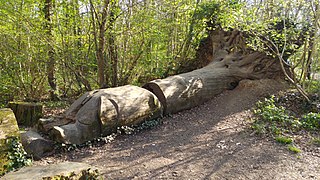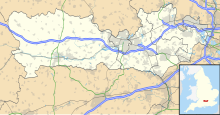
Sulham and Tidmarsh Woods and Meadows is a 75.7-hectare (187-acre) biological Site of Special Scientific Interest west of Reading in Berkshire. Previously known as Pang Valley SSSI, the site is mostly sandwiched between the River Pang and the Sulham Road and includes Broom Copse, Herridge's Copse, Hogmoor Copse, Park Wood, Moor Copse and Barton's Copse. Much of the southern part of the site is the Berkshire, Buckinghamshire and Oxfordshire Wildlife Trust's Moor Copse Nature Reserve. The whole site lies within the North Wessex Downs Area of Outstanding Natural Beauty.

Sandhurst to Owlsmoor Bogs and Heaths is an 85.8-hectare (212-acre) biological Site of Special Scientific Interest (SSSI) on the northern outskirts of Sandhurst in Berkshire. Part of the SSSI is Wildmoor Heath nature reserve, which is managed by the Berkshire, Buckinghamshire and Oxfordshire Wildlife Trust. and the SSSI is part of Thames Basin Heaths Special Protection Area.
Trodds Copse is a 25.23 hectare biological Site of Special Scientific Interest (SSSI), in central Hampshire, notified in 1989. It comprises ancient semi-natural woodland, unimproved meadows and flushes.

Decoy Pit, Pools and Woods is a 17.7-hectare (44-acre) biological Site of Special Scientific Interest south of Aldermaston in Berkshire. An area of 8 hectares is a nature reserve called Decoy Heath, which is managed by the Berkshire, Buckinghamshire and Oxfordshire Wildlife Trust.

Upper Wye Gorge is a Site of Special Scientific Interest (SSSI), noted for its biological and geological characteristics, around Symonds Yat in the Wye Valley on the Wales–England border. The site is listed in the 'Forest of Dean Local Plan Review' as a Key Wildlife Site (KWS).

Wykery Copse is a 3.2-hectare (7.9-acre) biological Site of Special Scientific Interest west of Bracknell in Berkshire.

Hog's Hole is a 23.7-hectare (59-acre) biological Site of Special Scientific Interest in the civil parish of Combe in the English county of Berkshire.

Old Copse, Beenham is an 8-hectare (20-acre) biological Site of Special Scientific Interest south of Beenham in Berkshire. The site is private land with no public access.

Heath Lake is a 6-hectare (15-acre) biological Site of Special Scientific Interest (SSSI) in Berkshire. The SSSI is part of the 22.3-hectare (55-acre) Heathlake Local Nature Reserve, which is owned and managed by Wokingham District Council.

Great Thrift Wood is a 14.2-hectare (35-acre) biological Site of Special Scientific Interest in Cox Green in Berkshire. The site is a broadleaved, mixed and yew woodland located in a lowland area. The wood was classed in 1984 as a Site of Special Scientific Interest.

Coombe Wood, Frilsham is a 19.3-hectare (48-acre) biological Site of Special Scientific Interest south of Frilsham in Berkshire. It is in the North Wessex Downs, which is an Area of Outstanding Natural Beauty.

Catmore and Winterly Copses is a 25-hectare (62-acre) biological Site of Special Scientific Interest north-west of Kintbury in Berkshire.

Enborne Copse is a 11.9-hectare (29-acre) biological Site of Special Scientific Interest west of Newbury in Berkshire. It is a Nature Conservation Review site.

Wasing Wood Ponds is a 13.5-hectare (33-acre) biological Site of Special Scientific Interest south of Aldermaston in Berkshire.

Chawridge Bourne is a 9.4-hectare (23-acre) biological Site of Special Scientific Interest in Berkshire, England Part of the site is a 5-hectare (12-acre) nature reserve called Chawridge Bank, which is managed by the Berkshire, Buckinghamshire and Oxfordshire Wildlife Trust.

Wraysbury and Hythe End Gravel Pits is a 117.2-hectare (290-acre) biological Site of Special Scientific Interest in Wraysbury in Berkshire. It is part of South West London Waterbodies Ramsar site and Special Protection Area.

Clayfield Copse is a local nature reserve on the northern edge of the suburb of Caversham in Reading, UK. The site is 8.65 hectares in size and is a natural open space consisting of fields, wild flower meadow and native woodlands adjoining the Oxfordshire countryside. Some of the woodland is being actively managed as hazel coppice, and traditional dead hedging defines some of the ancient woodland areas. The site is the only outcrop of London Clay north of the River Thames in Reading and makes up the southern tip of the Chiltern Hills. The nature reserve is under the management of the Reading Borough Council.

















